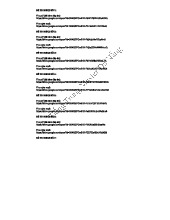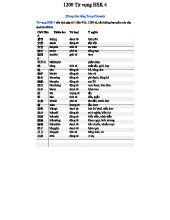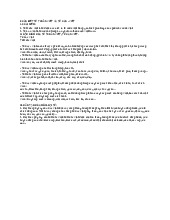








Preview text:
lOMoAR cPSD| 30964149
Student 2pathways rw3 2e u2 test
Kỹ năng tiếng (Trường Đại học Ngoại ngữ, Đại học Đà Nẵng) lOMoAR cPSD| 30964149
Pathways Reading, Writing, and Critical Thinking 2e: Level 3 Unit 2 Test Name: _ Class: Date: 1. VOCABULARY 1:
Complete the paragraph with the words in the box. Not all words will be used. analysis committed detectives determine examine heal mystery prove revealed suspects
Between 1545 and 1550, the Aztec people of southern Mexico were affected by a serious disease that they could neither cure nor (1)
. It was so serious, in fact, that up to eighty percent of the
entire population - 15 million people in total - are thought to have died. For almost five centuries, scientists were unable to (2)
which specific disease was the cause. Scientists had some (3)
, such as smallpox, malaria, or influenza, but it was not possible to (4)
that it was one of them. A new scientific study, however, might have solved this medical (5)
. The scientists had a chance to (6) some ancient
DNA found on victims of the disease. Their (7) of this evidence (8)
that the cause was one type of bacteria called salmonella, which remains a health problem even today. VOCABULARY 2:
Complete each sentence with a word from the box. Not all words will be used. archaeologist carry out combination identity mention moreover obtain sample suffer from unclear
2. I always loved learning about ancient cultures, so I went to college with the intention of becoming a(n) .
3. The unusually extreme effects of the disease were caused by a(n) of several different factors.
4. Scientists have known for a long time that the fossil known as "Piltdown Man" is fake, but the
of the person who made it is still unknown.
5. In order to leave college for a period of time, you have to permission from your academic advisor. 6. Police detectives have to
investigations in order to solve crimes. 7. There are many people who work-related stress.
8. The police managed to take a small blood from the crime scene. lOMoAR cPSD| 30964149 READING REVIEW 1:
Review the excerpt from a passage in Unit 2. Then read the statements and determine whether the
information is True, False, or Not Given. Tech Detectives
Europe's oldest mummy, now known as the Iceman, was discovered by hikers in the frozen
ice of the Italian Alps in 1991. Scientists believe he lived about 5,300 years ago in an area
north of what is now Bolzano, Italy. Wounds on the Iceman's body clearly show that he died
a violent death. But CT imaging technology has helped scientists piece together even more
clues about the life and death of this ancient Neolithic human.
CT imaging identified an arrowhead buried in the Iceman's left shoulder, indicating that he
was shot from behind. Scientists also discovered a wound on one of his hands. This told them
that he had likely been in a fight and that his enemies later chased after and killed him. While
this may be true, close analysis of this hand injury shows that the wound was already
beginning to heal at the time of his death. So it is unlikely he injured his hand in his final
days. Moreover, a later study of the CT images revealed that the Iceman had a full stomach at
the time he was killed. This meant that he ate a big meal immediately before his death - not
something a person would do if enemies were chasing him. Scientists guessed that the
Iceman might have been resting after a meal when enemies attacked him from behind.
Perhaps the most likely explanation is that the Iceman was fleeing an earlier battle, but
thought he was safe at the moment of his murder. Scientists continue to analyze the Iceman
using the latest technology to find more clues to history's oldest murder mystery.
9. CT imaging helped scientists discover how much food the Iceman ate at his last meal. a. True b. False c. Not Given
10. The Iceman's home was probably in northern Italy. a. True b. False c. Not Given
11. The evidence suggests that the Iceman's hand injury caused his death. a. True b. False c. Not Given
12. The Iceman's death seems to have been the result of a violent attack. a. True b. False c. Not Given lOMoAR cPSD| 30964149 READING REVIEW 2:
Review the excerpt from a passage in Unit 2. Then read the statements and determine whether the
information is True, False, or Not Given.
King Tut's Family Secrets
When Tutankhamun died about 3,000 years ago, he was secretly buried in a small tomb near
what is now the city of Luxor. When archaeologists rediscovered the tomb in 1922, the king's
treasures - more than 5,000 artifacts - were still inside. Among the artifacts was the pharaoh's
solid gold coffin and a gold mask. There were also 130 staffs, or walking sticks.
Mysteriously, an examination of Tutankhamun's mummy revealed a hole in the back of his
skull. Also, there were two mummified fetuses in the tomb.
These mummies and artifacts were an extremely important archaeological discovery, but
they did not answer many questions about the young pharaoh and his family. Who were his
mother and father? Were the two fetuses his unborn children? Could the hole in Tut's head be
related to his cause of death? To solve these mysteries required further study and the use of CT scans and DNA analysis.
In 2005, my colleagues and I carried out CT scans of Tutankhamun's mummy. We showed
that the hole in Tutankhamun's skull was made during the mummification process. Our study
also showed that Tutankhamun died when he was only 19, soon after fracturing his left leg.
However, the CT scans alone could not solve the mystery of how the king died, or why he died so young.
In 2008, my colleagues and I decided to analyze samples of Tutankhamun's DNA. Early in
the study, our team made some new discoveries: Tutankhamun's left foot was clubbed, and
one toe was missing a bone. A condition known as necrosis (tissue death) had destroyed
some bones in the foot. The discovery explained why there were so many staffs in
Tutankhamun's tomb. Some scholars had argued that the staffs were symbols of power. Our
DNA study showed that the king needed the staffs to walk.
13. The archaeologists who discovered Tutankhamun's tomb were looking for gold coins. a. True b. False c. Not Given
14. Scans and analysis show that the hole in Tutankhamun's skull was made before he died. a. True b. False c. Not Given
15. Analysis of Tutankhamun's mummy suggests he died when he was still in his teens. a. True b. False c. Not Given lOMoAR cPSD| 30964149
16. CT scans proved that Tutankhamun needed staffs to walk. a. True b. False c. Not Given READING PRACTICE:
Read the passage. Then answer the questions. A
Fossils are rare. Most of us will never find the skeleton of a dinosaur in our yards or even in the
wild. And even when we do find the fossil of some ancient creature, it is usually just a small shell or an
unrecognizable part of something that lived hundreds of millions of years ago. A well-preserved fossil is a
beautiful object, however, and many people would be happy to display one in their homes. In the past, it
was difficult to purchase fossils. These days, however, the Internet means rare or unusual fossils may be
just a mouse-click away. This fact, combined with fossils' relative rarity, makes them an attractive target
for people seeking to make money by selling fakes. B
Although fossils are generally rare, there are places where they are surprisingly widespread. In
some of these locations, it is possible to find a great many fossils just lying among the rocks. The vast
majority of them are just ugly pieces of broken bone. To the untrained eye, in fact, they may even look
like chunks of rock. Some of these low-quality fossils are sold illegally, especially over the Internet, but
what collectors are really interested in are high-quality fossils. People want to have a fossil that they can
recognize, such as one of a complete animal or insect. And for those with plenty of money, the most
valued and desired fossil is a well-preserved, complete dinosaur. C
The problem is that the demand for high-quality fossils far exceeds the supply. As a result, more
and more fake fossils are flooding the market. Most of the fakes that are sold online or to unsuspecting
tourists are completely artificial and even easy for knowledgeable amateurs to spot. But some of the best
fake fossils are made from real fossils, and these can be hard to recognize as fake. For example, fossils
from individuals of the same species found in different places and at different times can be joined to form
a complete animal. Alternatively, pieces of completely different animals may be joined to make a "new
species." The discovery of a new fossil species is a major scientific event, so people making fake fossils
realize that a very rare fossil might be worth thousands of dollars. Consequently, extremely realistic fakes
have become quite common in recent years. In fact, some fake fossils are so well made that scientists have been fooled at first. D
In 1999, paleontologists announced the discovery of a fascinating new dinosaur called
Archaeoraptor. This species seemed to be a clear link between dinosaurs and birds. News of the find was
published in serious scientific journals and was widely reported in the popular media, too. However, after
closer examination, it turned out that the fossil was a fake made by joining the tail of dinosaur together
with the arms of a primitive bird. Archaeoraptor is now considered one of the most successful scientific hoaxes of the past century. E
Apart from embarrassing some scientists, what is the danger of fake or illegal fossils? The
biggest problem is that people collecting fossils to sell on the Internet cause enormous damage to the
regions in which the fossils are found. Many fossils that are important to science are destroyed in an effort
to get to the most attractive specimens. Moreover, even when these fossils are collected with good
intentions, a great deal of valuable information is lost. In addition to the fossil itself, scientists need to
know exactly where a fossil was found in order to know how old it is and what kind of environment the
animal lived in. Fortunately, governments are starting to realize the value of their fossil resources and are
making an effort to protect them. lOMoAR cPSD| 30964149
17. What is the best title for this passage? a. Where to Buy Real Fossils
b. The Problem of Fake Fossils c. A Guide to Finding Fossils
18. What point does the author NOT make in paragraph A?
a. It is possible to purchase fossils using the Internet.
b. It is not easy to recognize the species of some fossils.
c. People like attractive fossils because they are rare.
19. The word "widespread" in paragraph B is closest in meaning to . a. common b. significant c. damaged
20. The word "them" in the third sentence of paragraph B refers to . a. rocks b. fossils c. locations
21. What does the author imply in paragraph B?
a. Complete dinosaur fossils generally sell for more money than other types of fossils.
b. People are less skilled at recognizing fossil skeletons these days than they were in the past.
c. At places where there are a lot of fossils, people have accidentally broken many of them.
22. What is the author's main purpose in paragraph C?
a. To contrast the appearance of real fossils and fake fossils
b. To explain why and how some people make fake fossils
c. To suggest archaeologists can recognize most fake fossils
23. What point does the author make in paragraph D?
a. Archaeoraptor was the greatest scientific discovery in the 20th century.
b. Archaeoraptor was created as a result of media interest in fossils.
c. Even though it was a fake, the Archaeoraptor fossil was believable.
24. What is the author's opinion about fake fossils in paragraph E?
a. Concerned they will become more common
b. Realistic about the challenges and solutions
c. Frustrated about the lack of official reaction lOMoAR cPSD| 30964149
READING SKILL REVIEW - IDENTIFYING A SEQUENCE OF EVENTS:
Review these excerpts from three reading passages. Then read the statements and choose True
if the events happened in this order. False
if the events happened in a different order. Not Certain
if there is not enough information to say that these events happened. Passage 1
CT imaging identified an arrowhead buried in the Iceman's left shoulder, indicating that he
was shot from behind. Scientists also discovered a wound on one of his hands. This told them
that he had likely been in a fight and that his enemies later chased after and killed him. While
this may be true, close analysis of this hand injury shows that the wound was already
beginning to heal at the time of his death. So it is unlikely he injured his hand in his final
days. Moreover, a later study of the CT images revealed that the Iceman had a full stomach at
the time he was killed. This meant that he ate a big meal immediately before his death - not
something a person would do if enemies were chasing him. Scientists guessed that the
Iceman might have been resting after a meal when enemies attacked him from behind. Passage 2
When Tutankhamun died about 3,000 years ago, he was secretly buried in a small tomb near
what is now the city of Luxor. When archaeologists rediscovered the tomb in 1922, the king's
treasures - more than 5,000 artifacts - were still inside. Among the artifacts was the pharaoh's
solid gold coffin and a gold mask. There were also 130 staffs, or walking sticks.
Mysteriously, an examination of Tutankhamun's mummy revealed a hole in the back of his
skull. Also, there were two mummified fetuses in the tomb.
[...] In 2005, my colleagues and I carried out CT scans of Tutankhamun's mummy. We
showed that the hole in Tutankhamun's skull was made during the mummification process.
Our study also showed that Tutankhamun died when he was only 19, soon after fracturing his
left leg. However, the CT scans alone could not solve the mystery of how the king died, or why he died so young. Passage 3
In 1999, paleontologists announced the discovery of a fascinating new dinosaur called
Archaeoraptor. This species seemed to be a clear link between dinosaurs and birds. News of
the find was published in serious scientific journals and was widely reported in the popular
media, too. However, after closer examination, it turned out that the fossil was a fake made
by joining the tail of dinosaur together with the arms of a primitive bird. Archaeoraptor is
now considered one of the most successful scientific hoaxes of the past century.
25. (Passage 1) The Iceman was hurt in a fight. Later he had a large meal. Shortly after, he was attacked from behind. a. True b. False c. Not Certain lOMoAR cPSD| 30964149
26. (Passage 2) King Tutankhamun was buried near Luxor. His tomb was rediscovered. A hole was made in his skull. a. True b. False c. Not Certain
27. (Passage 2) Scientists made several CT scans of Tutankhamun's skull. They examined the mummification
process in detail. They learned some new facts about Tutankhamun's birth and family. a. True b. False c. Not Certain
28. (Passage 3) News of a newly-discovered dinosaur was published. The fossil was examined in more detail.
People changed their opinion about whether it was real or fake. a. True b. False c. Not Certain
LANGUAGE FOR WRITING REVIEW - PARAPHRASING:
Choose the TWO phrases that have the same meaning as the underlined phrase in each sentence.
29. The student was tired, so he decided to leave some of his work until the following day. a. for another day b. and do it tomorrow c. after one more day d. so he could sleep soon
30. During her lecture, the professor strongly implied that she accepted one theory more than the others. a. In her talk b. In the middle c. After the class d. While speaking
31. The students at the college were delighted when their team won the national soccer championship.
a. played the championship-winning team
b. won the game and became the champions
c. defeated another team to win the championship
d. decided to try and become the champions
32. Some students feel that the chance to attend college overseas is a great opportunity. a. is an important decision b. is a wonderful chance c. is something they must do d. could be very beneficial lOMoAR cPSD| 30964149
WRITING SKILL REVIEW - WRITING A SUMMARY: Tech Detectives
Europe's oldest mummy, now known as the Iceman, was discovered by hikers in the frozen
ice of the Italian Alps in 1991. Scientists believe he lived about 5,300 years ago in an area
north of what is now Bolzano, Italy. Wounds on the Iceman's body clearly show that he died
a violent death. But CT imaging technology has helped scientists piece together even more
clues about the life and death of this ancient Neolithic human.
CT imaging identified an arrowhead buried in the Iceman's left shoulder, indicating that he
was shot from behind. Scientists also discovered a wound on one of his hands. This told them
that he had likely been in a fight and that his enemies later chased after and killed him. While
this may be true, close analysis of this hand injury shows that the wound was already
beginning to heal at the time of his death. So it is unlikely he injured his hand in his final
days. Moreover, a later study of the CT images revealed that the Iceman had a full stomach at
the time he was killed. This meant that he ate a big meal immediately before his death - not
something a person would do if enemies were chasing him. Scientists guessed that the
Iceman might have been resting after a meal when enemies attacked him from behind.
Perhaps the most likely explanation is that the Iceman was fleeing an earlier battle, but
thought he was safe at the moment of his murder. Scientists continue to analyze the Iceman
using the latest technology to find more clues to history's oldest murder mystery.
33. Which five sentences should be included in a summary of the passage?
a. In general, it is unusual for people to eat when they are chasing or being chased.
b. It is not clear what kinds of food the Iceman would usually have eaten for his meals.
c. It is possible the Iceman had run away from a previous fight before he was murdered.
d. Medical scans of the body showed the Iceman had an arrowhead in his shoulder.
e. One theory is that the Iceman was killed while he was relaxing after eating a meal.
f. The discovery of a body frozen in the mountains was made by some hikers in 1991.
g. The scans also showed that the Iceman had eaten a large meal before he was killed. lOMoAR cPSD| 30964149 WRITING PRACTICE 1:
Look at this summary of a passage about fossils. Each sentence has one mistake. Find and correct the errors.
People who producing fake fossils think they can make a lot of money by creating a fake
fossil of a new dinosaur. As a result, fake fossils that look very real have become more
common recent. Some of them, such as the fossil of Archaeoraptor, has even confused
archaeologists. This fossil seemed to be a clear link between birds to dinosaurs. It was
reported in scientific journals as well as in newspapers, but when people studied the
fossil more closer, they realized it was a fake.
34. How can you correct the mistake in the first sentence?
35. How can you correct the mistake in the second sentence?
36. How can you correct the mistake in the third sentence?
37. How can you correct the mistake in the fourth sentence?
38. How can you correct the mistake in the final sentence? WRITING PRACTICE 2:
Mary Anning lived on the south coast of England from 1799 to 1847. Her name may not be
familiar, but she is one of the most influential British women in the history of science. She
was one of the first people to collect fossils and analyze them in a scientific way. She also
sold some of the fossils that she found while walking along the sea shore. In fact, many
people believe that the famous tongue twister "She sells seashells on the sea shore"
describes Mary Anning. Unfortunately, she did not make a lot of money from this, and
Anning was poor for most of her life.
39. Write a summary of this short passage. Make sure you use techniques like combining ideas, using
synonyms, and using different parts of speech.





